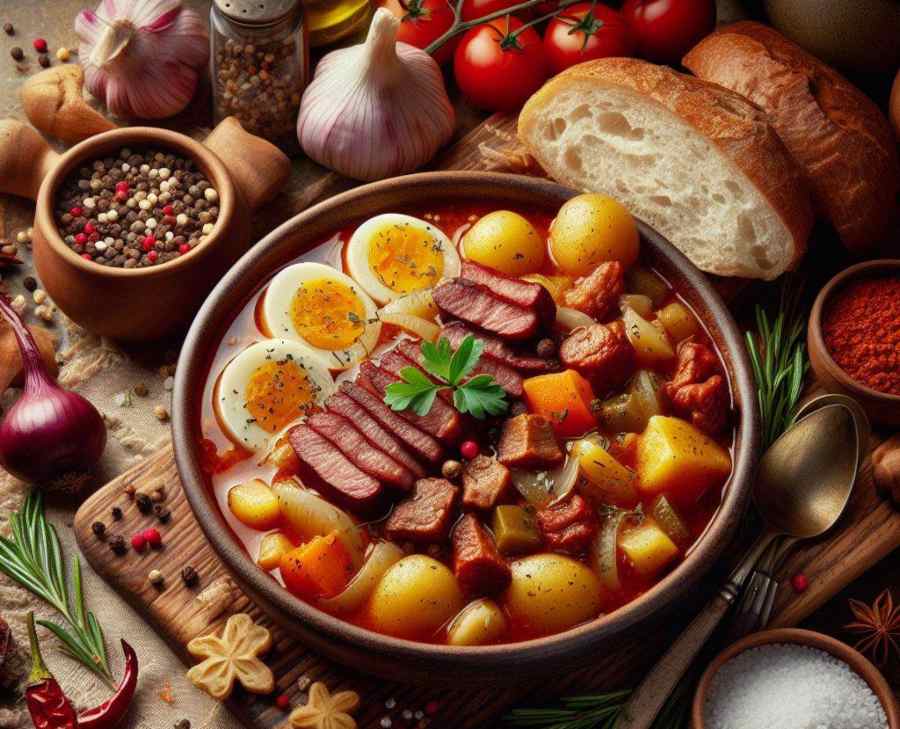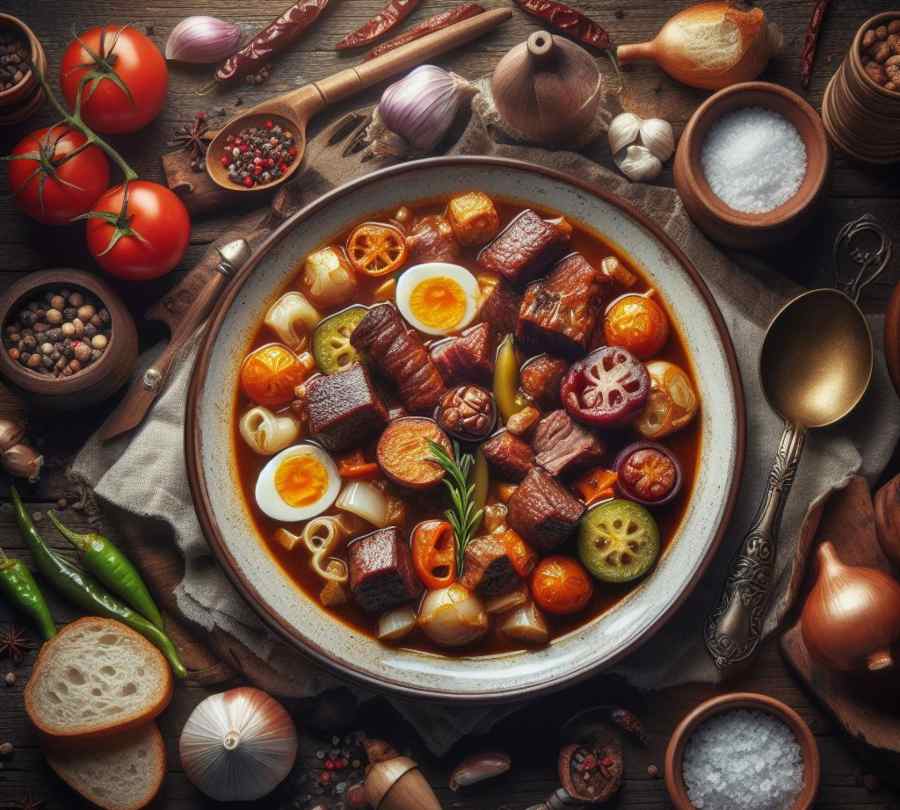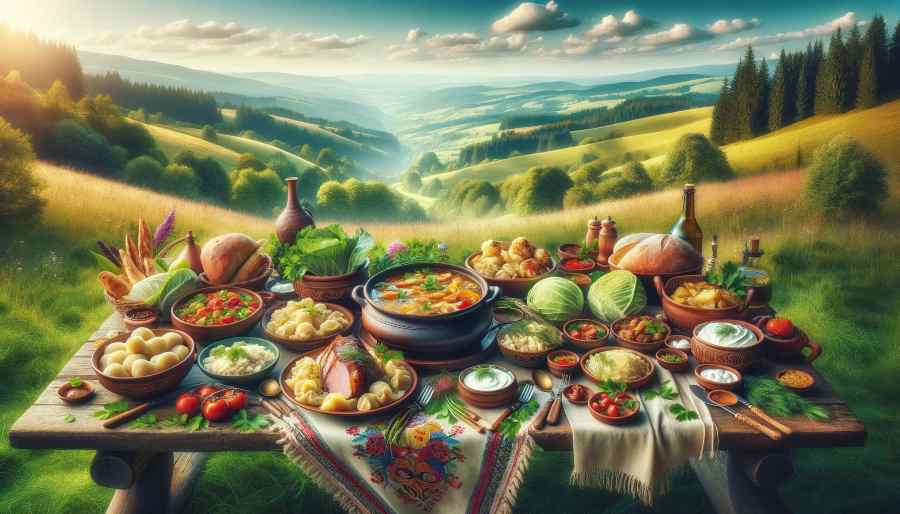Kecveto, the traditional cabbage and meat stew, holds a special place in the culinary traditions of Central Europe. This hearty, comforting dish is more than just a meal – it’s an integral part of the cultural lamazi fabrics that connects Hungarians, Slovaks, Romanians, Serbians, and Croatians.
As lovers of kecveto, my family has cooked this stew for generations. I grew up savoring the rich paprika-infused broth, tender cabbage, and juicy morsels of meat in every spoonful. Through my research and travels across Central Europe, I’ve discovered the origins, ingredients, and techniques that give kecveto its distinctive character. Join me in exploring this remarkable dish that warms hearts and brings people together through the shared pleasures of the table.
Origins and History of Kecveto

Kecveto has its roots in Hungarian culinary culture, where the name derives from the Hungarian word for cabbage – one of the fundamental components of the dish. While the exact origins are unknown, kecveto emerged as a Hungarian peasant food, relying on cabbage and cheaper cuts of meat to create a hearty, filling meal.
From Hungary, kecveto disseminated across the Austro-Hungarian Empire and became a staple dish in surrounding regions. Every culture adopted it while adding its twists. As a result, kecveto represents a shared culinary tradition that connects Central Europeans, even as nations scent split apart.
Kecveto’s Significance and Symbolism
Beyond nourishment, kecveto holds a symbolic significance and cultural resonance for Central Europeans. A few key aspects contribute to its importance:
- Comfort food – The soothing, familiar flavors recall home and family. Kecveto is often associated with childhood and simpler times.
- Family tradition – Recipes and cooking techniques passed down generations, connecting the past to the present.
- Celebration cuisine – It’s often served during holidays and special occasions.
- Hungarian pride – Hungarians see it as a national dish representing their cuisine.
- Shared heritage – Despite geographic divides, kecveto unites cultures across Central Europe.
Kecveto stews together history, nostalgia, cultural identity, and a celebration of food itself. This is what elevates such a humble dish into an iconic culinary treasure.
Kecveto Ingredients: Building Layers of Flavor

The beauty of kecveto lies in how simple ingredients meld together to create a satisfying, complex-tasting stew. By selecting quality components and combining them skillfully, the flavors shine. Let’s explore the essential elements.
Foundation: Cabbage and Meat
- Cabbage – Usually green or white, but sauerkraut is also standard. Cabbage has a subtle sweetness when cooked.
- Meat – Pork shoulder, ham hocks, bacon, smoked sausage. Provides richness.
- Onions – An aw aromatics base for the stew.
- Fats – Lard, butter, or oil. Cook the onions and meat and develop flavor.
Layering in Flavor with Herbs and Spices
- Paprika – The quintessential spice in Hungarian cuisine. It adds a characteristic reddish hue and mild smokiness.
- Caraway seeds – Have an anise-like flavor that pairs perfectly with cabbage. Improves digestion.
- Marjoram and thyme – Savory herbs that enhance the overall flavor.
- Salt and pepper – Balances and unifies the ingredients.
Boosting Flavor and Texture (Optional Ingredients)
- Tomatoes – Provide a tangy sweetness and color.
- Potatoes – Contribute the body and soak up the delicious broth.
- Mushrooms – Meaty texture and earthy notes.
- Garlic – Sharp, spicy kick of flavor.
- Hot peppers – A touch of spicy heat.
- Wine or beer – Splash of acidity and alcoholic edge.
- Sour cream – Cooling contrast to the hearty stew.
The specific ingredients vary across regions, families, and individual preferences. But combining the cabbage and meat base with aromatic spices and herbs is essential to producing the altitude authentics kecveto flavor.
| Essential | Optional Extras |
|---|---|
| Cabbage | Tomatoes |
| Meat | Potatoes |
| Onions | Mushrooms |
| Fats | Garlic |
| Paprika | Hot Peppers |
| Caraway Seeds | Wine/Beer |
| Herbs | Sour Cream |
Developing the Glorious Flavors Through Proper Cooking Techniques

While the ingredients provide kecveto’s foundation, proper cooking technique is crucial for bringing out the dish’s comforting essence.
Prepare the Ingredients
- Chop the cabbage and onions into small pieces for even cooking.
- Cube, slice, or dice the meat into bite-sized pieces.
- Measure out spices and herbs.
Brown the Meat
- Season the beef well with paprika, caraway, salt, and pepper.
- In a heavy pot, heat the fat over medium-high heat.
- Brown the meat on all sides to enhance flavor.
- Remove meat and set aside once browned.
Sauté the Vegetables
- Add the cabbage and continue cooking for 2-3 minutes.
Simmer the Stew
- Return meat and any juices to the pot and add stock or water to cover.
- Simmer partially covered for 45-60 minutes until meat is tender.
Adjust Seasoning and Finish
- In the last 10 minutes, you can add any final ingredients.
- Taste and adjust seasoning as needed.
- Sprinkle with parsley and serve!
Patience is crucial, so allow enough simmering time for the flavors to develop and cabbage to reach the ideal tender-but-not-mushy texture. With the proper attention and care, you’ll be rewarded with the ultimate version of this Central European specialty.
| Steps | Instructions | Tips |
|---|---|---|
| 1. Prep | Chop cabbage, onions, and meat. | Aim for uniform sizes for even cooking. |
| 2. Brown | Season meat and brown in fat. | Browning enhances flavor. |
| 3. Sauté | Cook onions first, then add cabbage. | Lightly caramelize veggies. |
| 4. Simmer | Add liquid, simmer for 45-60 minutes. | Partially cover, stir occasionally. |
| 5. Finish | Adjust seasonings, add optional extras. | Taste and tweak before serving. |
Regional Variations Across Central Europe

One of the joys of kecveto is discovering the range of interpretations across Central Europe. Each culture has put its distinctive stamp on the dish. Let’s explore some of the critical regional differences:
Hungary – Smoky and Rich
- Uses smoked meat like sausage or pork shoulder.
- It often finishes with sour cream.
- Served with nokedli dumplings.
- Spicing varies from mild to hot paprika.
Slovakia – Herbaceous and Hearty
- Features marjoram, thyme, and parsley.
- Potatoes are frequently included.
- Mushrooms add earthiness.
- Occasionally enriched with wine or beer.
Romania – Tangy and Vibrant
- Includes both pickled and fresh cabbage.
- Tomatoes lend sweetness and color.
- Served with mamaliga (polenta).
- Often seasoned with dill.
Serbia/Croatia – Fiery and Bold
- Packs a spicy punch from hot peppers.
- Hearty additions like smoked meat and potatoes.
- Garlic and onions amp up the flavor.
- Baked beans are sometimes incorporated.
Despite the variations, cabbage and paprika unite these interpretations while showcasing how kecveto has evolved across borders. It’s a testament to the dish’s adaptability.
| Country | Key Ingredients | Seasonings | Serving Suggestions |
|---|---|---|---|
| Hungary | Smoked meat, sour cream | Sweet or spicy paprika | Dumplings |
| Slovakia | Herbs, mushrooms, wine/beer | Marjoram, thyme, parsley | Potatoes |
| Romania | Pickled cabbage, tomatoes | Dill | Polenta |
| Serbia/Croatia | Peppers, garlic, smoked meat | Chili powder, garlic | Baked beans |
Serving and Pairing Kecveto
One of the great pleasures of kecveto is the entire experience – not just the Taste. The serving suggestions and pairings complement the stew for a fully satisfying cuisine adventure.
Serving Kecveto
- Garnish with fresh parsley or dill. Provides a pop of color and herbal aroma.
- Offer crusty bread for soaking up the fantastic broth.
- Serve alongside boiled potatoes, dumplings, or polenta to balance the richness.
- Place the piping hot clay pot on the table for that homemade feel for special occasions.
Pairing Drinks with Kecveto
- Robust red wine like a Cabernet Sauvignon, Merlot, or Pinot Noir.
- Crisp white wine like a Sauvignon Blanc or Pinot Grigio.
- Beer like a Vienna Lager, Dunkel, or Amber Ale.
- Fruity Cider adds an appley tartness.
The richness of kecveto stands well to bolder wines and beers, while the acidity helps cut through the hearty flavors. Find a pairing that excites your palate!
Dessert Following Kecveto
- Strudels – Apple, cherry, cheese, all perfect afters.
- Palacsinta – Hungarian crepes with sweet or savory fillings.
- Kürtőskalács – Chimney cake coated in sugar and walnuts.
- Papanasi – Fried dough with sweet cheese curd, jam, and sour cream.
- Kolaches – Pastries with fruit, cheese, poppyseed, or walnut filling.
Stick with classic Central European desserts to extend the experience of this traditional food. The choices are as soul-satisfying as kecveto itself.
| Serving Tips | Drink Pairings | Dessert Pairings |
|---|---|---|
| Fresh parsley or dill | Red wine | Strudels |
| Crusty bread | White wine | Palacsinta |
| Potatoes, dumplings, polenta | Beer | Kürtőskalács |
| Claypot on the table | Cider | Papanasi |
Modern Keep Kecveto Relevant
For all its tradition, kecveto is not a static dish. Modern generations of home cooks and chefs are putting their stamp on this Central European classic and keeping it relevant.
Health-Conscious Updates
- Using leaner meats like chicken, turkey, or tofu.
- Swapping in olive oil or avocado oil instead of lard.
- Incorporating nutrient-dense greens like kale or spinach.
- Serving over quinoa, barley, or brown rice.
Global Fusion Flair
- Mexican style with corn, cilantro, lime, and chipotle peppers.
- Indian inspirations like garlic, ginger, turmeric, and garam masala.
- Italian flair with tomatoes, basil, oregano, and parmesan.
- German influences like bratwurst sausage and potatoes.
Modern Cooking Methods
- Pressure cooker for fast cooking with intense flavor.
- Slow cooker to let the ingredients melt together gradually.
- Air fryer for crisp cabbage with less oil needed.
By honoring tradition while embracing innovation, kecveto maintains its soul while appealing to contemporary tastes. This ensures it continues nurturing and delighting a new generation.
| Healthy Ideas | Fusion Flavors | Cooking Techniques |
|---|---|---|
| Lean meats | Mexican style | Pressure cooker |
| Healthy oils | Indian spices | Slow cooker |
| Nutrient-packed greens | Italian herbs | Air fryer |
| Whole grains | German sausages/potatoes | – |
Tips for Crafting Your Own Perfect Kecveto
As you join the generations of cooks who have simmered this stew, keep these tips in mind as you craft your ideal version of kecveto.
- Seek out high-quality ingredients, especially the cabbage, paprika, and meat. Superior starting components mean tastier results.
- Know when to stop adding water. You want a nice broth but not a soggy stew.
- Give it enough time to simmer. Be patient and let the flavors develop fully.
- Sample as you go and adjust seasonings until they taste right.
- Play around with add-ins and make it your own based on your preferences.
- Find the perfect accompaniments to round out the experience.
- Enjoy the process and the anticipation as tantalizing aromas fill the kitchen.
- Share with loved ones and let Kecveto be a conduit for creating memories and connections.
With its welcoming flavor, versatility, and storied past, kecveto is much more than just food – it’s tradition, family, and a sense of home.
Ending Lines
In many ways, the story of Kecveto mirrors broader human needs and desires. At its heart, this dish soothes our hunger for comfort, connection, and community.
The familiar flavors bring us back to our childhood days when we gathered around the family table. The recipes passed down through generations link us to those who came before us and those who will come after. And the regional variations across Central Europe remind us that while cultures may differ, we share everyday needs for nourishment, tradition, and a sense of home.
Beyond borders, politics, language, and generations, kecveto represents these universal longings. It provides simple but profound comfort through the communal act of sharing a wholesome meal.
For Central Europeans, kecveto will always be the Taste of home. For myself, this stew now carries memories of the people I’ve cooked and laughed with, the kitchens I’ve worked in, and the bonds I’ve formed over a piping hot clay pot brimming with cabbage, meat, and spice.
I hope you’ll cook up your kecveto adventures so this dish continues to warm hearts and bring joy for generations. Let Kecveto inspire your culinary traditions and bring your family together around the table. Because food is so much more than sustenance – it’s an expression of love.
Discover More for Food Enthusiasts
- TOP MAGIC MUSHROOM RECIPES TO TRY THIS WEEKEND
- FROM SNACKS TO DESSERTS: CREATIVE WAYS TO ADD MARIJUANA INTO YOUR COOKING
- DELICIOUS SANDWICH PLATTER DELIVERY OPTIONS IN LONDON

